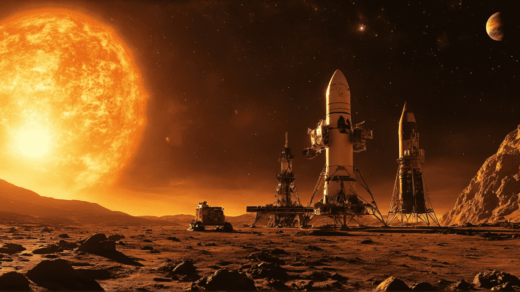Hey there, fellow space enthusiasts! Can you believe we’re actually talking about colonizing Mars? It’s not just the stuff of sci-fi movies anymore – it’s a real possibility that’s got scientists, engineers, and dreamers like me absolutely buzzing with excitement. Did you know that Mars has about the same amount of dry land as Earth, despite being only half its size? It’s like one giant, rusty desert just waiting for us to explore!

I’ve been obsessed with the idea of Mars colonization ever since I was a kid, watching grainy footage of the Moon landings and dreaming about what it would be like to set foot on another world. Now, after years of research and countless conversations with experts in the field, I’m thrilled to share what I’ve learned about our quest to establish life beyond Earth. So, strap in, and let’s blast off into the fascinating world of Mars colonization!
The Red Planet’s Fascination: Why Mars?
You might be wondering, “Why Mars? Why not Venus or, I don’t know, Pluto?” Well, let me tell you, Mars has got it going on when it comes to potential colonization spots. For starters, it’s relatively close to Earth – I mean, it’s still millions of miles away, but in cosmic terms, that’s practically next door!
But here’s the real kicker: Mars has a lot of similarities to Earth that make it a prime candidate for colonization. It’s got a 24.5-hour day (called a sol), seasons, polar ice caps, and even some water in the form of ice. Plus, its gravity is about 38% of Earth’s, which is way better than the Moon’s 17%.
I remember once a NASA scientist said at a conference that blew my mind. She said, “Mars isn’t just a backup plan for humanity. It’s a stepping stone to the rest of the solar system and beyond.” That really put things into perspective for me!
Technological Hurdles in Mars Colonization
Now, don’t get me wrong – colonizing Mars isn’t going to be a walk in the park. There are some serious technological challenges we need to overcome before we can start packing our bags for the Red Planet.

First up: getting there. The journey to Mars takes about 6-8 months with current technology. That’s a long time to be cooped up in a spacecraft! We need to develop faster propulsion systems to cut down on travel time and reduce the risks associated with long-duration space flight.
Then there’s the whole issue of landing on Mars. Remember, Mars has a much thinner atmosphere than Earth, which makes it tricky to slow down spacecraft for a safe landing. We’ve managed to land rovers like Perseverance, but landing a crew and all the necessary equipment? That’s a whole different ballgame.
And don’t even get me started on radiation protection! Mars doesn’t have a magnetic field like Earth does, so colonists would be exposed to dangerous levels of cosmic radiation. We need to figure out how to shield our Martian homes and spacesuits to keep everyone safe or we might all end up looking like Fantastic Four if we are not careful!
Living on Mars: Creating a Sustainable Habitat
So, let’s say we’ve made it to Mars – now what? Well, we can’t exactly pitch a tent and call it a day. Creating a sustainable habitat on Mars is going to be one of the biggest challenges we face.

First things first: we need air to breathe. Mars’s atmosphere is mostly carbon dioxide, which isn’t exactly ideal for human lungs. We’ll need to set up systems to produce oxygen, probably by splitting water molecules through electrolysis. It sounds simple, but doing this on a large scale in a hostile environment? Not so much.
Then there’s the issue of food and water. We can’t exactly order takeout on Mars (although wouldn’t that be nice?). We’ll need to figure out how to grow food in Martian soil and recycle water with incredible efficiency. Here is how it might look like growing food on Mars(just kidding).

The Human Factor: Psychological Challenges of Mars Settlement
Now, here’s something that doesn’t get talked about enough: the psychological toll of living on Mars. Imagine being millions of miles from home, in a hostile environment, with only a handful of other people for company. It’s enough to make anyone a little stir-crazy!
I’ve watched a few astronauts who’ve spent long periods on the International Space Station, and they all say the same thing: the isolation is tough. Now multiply that by about a thousand for Mars colonists. They’ll be dealing with communication delays of up to 20 minutes each way, limited resources, and the constant stress of knowing that one small mistake could be fatal.
We’ll need to develop robust support systems and carefully select colonists who can handle the mental strain. Maybe we should send a few therapists on the first missions – I have a feeling they’d be pretty busy!
Timeline and Major Players in the Mars Race
So, when are we actually going to set foot on Mars? Well, if you ask different people, you’ll get different answers. NASA has plans for crewed missions to Mars in the 2030s, while SpaceX’s Elon Musk has made some pretty bold claims about colonizing Mars even sooner.
It’s not just the USA in this race, either. China, the UAE, and even private companies are all throwing their hats into the ring. It’s like the space race of the 1960s all over again but with Mars as the finish line!

I’ve been following these developments pretty closely, and I gotta say, it’s exciting to see the progress being made. Just a few years ago, landing reusable rockets seemed like a pipe dream. Now it’s becoming routine. Who knows what breakthroughs we’ll see in the next decade?
Ethical Considerations of Colonizing Another Planet
Now, here’s where things get a bit philosophical. Is it right for us to colonize Mars? Some argue that we should focus on solving Earth’s problems before spreading to other planets. Others say that becoming a multi-planetary species is crucial for our long-term survival.
And what if we find life on Mars? Even if it’s just microbial, how do we balance our colonization efforts with the need to study and preserve potential Martian life forms?
These are tough questions without easy answers. Personally, I think exploration and preservation can go hand in hand if we’re careful and thoughtful about our approach. But it’s definitely something we need to keep talking about as we move forward with Mars colonization plans.
The Future of Humanity: Multi-Planetary Species
Alright, let’s zoom out for a second and look at the big picture. Mars colonization isn’t just about planting a flag or winning a race. It’s about securing the long-term future of our species.
By becoming a multi-planetary species, we’re essentially creating a backup plan for humanity. If something catastrophic were to happen to Earth (let’s hope it doesn’t!), having a thriving colony on Mars could ensure our survival.
But it’s more than that. The technologies we develop for Mars colonization could help us solve problems here on Earth, like creating more efficient renewable energy systems or developing better ways to grow food in harsh environments.
And who knows? Mars might be the first step. Once we figure out how to live on the Red Planet, we might set our sights on the moons of Jupiter or Saturn, or even other star systems. The possibilities are literally endless!
Conclusion
Whew! We’ve covered a lot, from the journey to Mars to building a colony. Mars colonization is ambitious, but I think we can do it. Every space tech breakthrough excites me—we’re turning science fiction into reality.
Want to join in? Stay informed, follow Mars missions, or explore aerospace. Next time you see that red dot in the sky, remember: it’s a potential future home. Keep reaching for the Red Planet—the future is looking exciting!
FAQ’s
- How long would it take to travel to Mars? With current technology, a one-way trip to Mars takes about 6-8 months. The exact duration depends on the positions of Earth and Mars in their orbits and the type of trajectory used. Scientists are working on developing faster propulsion systems to reduce travel time in the future.
- Can humans survive on Mars without spacesuits? No, humans cannot survive on Mars without protective gear. The Martian atmosphere is too thin to breathe, consisting mostly of carbon dioxide. Additionally, the surface temperature is extremely cold, and there’s no protection from harmful radiation.
- Is there water on Mars? Yes, there is water on Mars, but not in the form we’re used to on Earth. Most of the water on Mars exists as ice in the polar caps and beneath the surface. Scientists have also detected signs of liquid water flowing on the planet’s surface during warmer seasons, though this water is likely very salty.
- How would growing food on Mars work? Growing food on Mars would be challenging but possible. Colonists would likely use controlled environments like greenhouses to grow crops. They would need to use artificial lighting, as the sunlight on Mars is weaker than on Earth. The Martian soil would need to be treated to remove toxic elements and enriched with nutrients.



